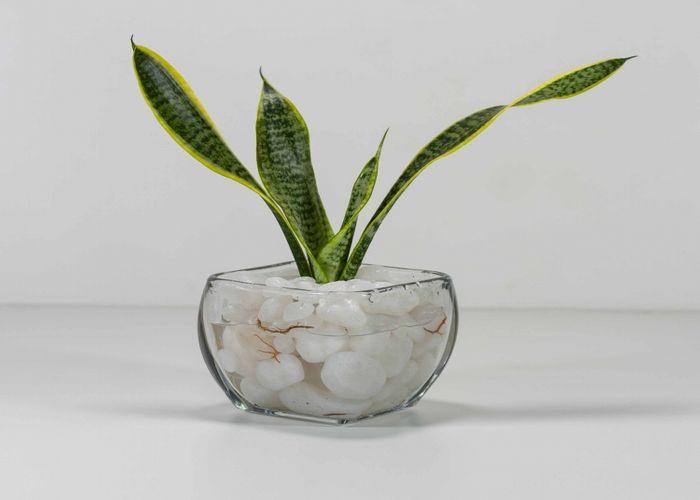One of the most versatile indoor plants is the snake plant. They are easy to maintain and go with any decor. For those of you picky about pots and soil, here are all the details on How to Grow Snake Plant in Water.
You might hear snake plants called Mother-in-Law’s Tongue or Devil’s Tongue and are considered unlucky for your home.
Despite their bad reputation, Snake Plants are tenacious houseplants favored for their easy care regime and bold appearance. They are so resilient that you can learn how to grow them completely in water without soil!
You can multiply Snake Plant leaves by using hydroponics, saving you headaches and money on the challenges of traditional soil planting. Want to know more? Discover how to grow a snake plant in water in this article.
But first, let us know how to propagate snake plants in the water!
How to Propagate Snake Plants in Water?

It is important to select how you want to propagate a Snake Plant from an existing one. Leaf cuttings and division are the two methods of propagating new Snake Plants. Pick your method, and let’s get to it.
1. Using the leaf Cuttings method
Select a Snake Plant that can handle losing a leaf or two. Additionally, you will need a knife or scissors. To prevent infection, clean your tool with rubbing alcohol. Cut one or two sturdy leaves (or however many new plants you want) from the base. Using a knife, cut them into 2 – 3 inch sections.
Be careful to remember which end of the cutting was closest to the base on the mother plant since the cutting will ONLY root from this end. That’s all! With your new Snake Plant cuttings, you can begin propagation and repot.
Follow these steps if you are rooting your Snake Plant in water and will not be transferring it to soil afterward:
- To hold the leaf, choose a container that is tall enough.
- Make sure the bottom quarter of the leaf is covered in water.
- Keep your plant in indirect light and change the water every couple of days until roots form (about 4 – 5 weeks).
- If you are using leaf cuttings, roots should form after a few weeks, so you can transfer them to a more permanent container and anchor it with pebbles.
- Add fertilizer to the water, so your plant gets enough nutrients.
2. The Division method
Using the division method, you can also divide a healthy, fully grown Snake Plant into smaller plants. In mature Snake Plants, rhizomes hold the plant’s energy and help it grow. Try not to damage the rhizome or roots when you remove the plant from its pot. At the base, divide the plant into sections. It is a good idea to leave three rhizomes per leaf.
It is also possible for Snake Plants to have offshoots that are easily separated and replanted. As with leaf cuttings, you grow division segments in water by following these steps:
- The container should be tall enough to hold the segment.
- Add pebbles or other anchoring rocks to the bottom of the container (optional).
- Cover the roots and a quarter of the rhizome with just enough water to completely cover the plant. When placing the plant in a container with pebbles at the bottom, cover the roots and rhizomes with pebbles (or your chosen medium) before adding water. It is best to keep the water level below the pebbles’ surface.
- Provide your plant with all the nutrients it needs by adding fertilizer to the water.
- Watch your plant grow in indirect light!
Do you know the requirements for growing snake plants in water?
No? Let’s know them now!
What are the requirements for Growing Snake Plants in Water?

Let us now explore the requirements that you need to know for growing snake plants in the water!
1. Light requirements for growing snake plant
In bright light, snake plants thrive. Make sure that the leaves are not kept in a dark place. It would be ideal if it could get direct morning sunlight for 2-3 hours each day from an east-facing window.
2. Water requirements for growing snake plant
Growing snake plants in water requires good water quality. You can use rainwater, a pond, a well, or RO water. If you are using tap water, let it sit overnight. If the water becomes discolored, you should change it every 5-7 days.
3. Temperature requirements for growing snake plant
Temperatures between 50-95 F (10-35 C) are ideal for water-grown snake plants. It prefers warm temperatures around 70F (22C).
4. Fertilizer requirements for growing snake plant
Once a month in spring and summer, use a liquid fertilizer designed for snake plants. Use half a spoonful of fertilizer in a gallon of water on the plant. Alternatively, aquarium water can be used.
Now that you know how to propagate and grow snake plants in water, let me tell you some important tips to maintain a snake plant in water.
Tips to maintain a snake plant in water

Although Snake Plants are easy to maintain, growing them in water still requires some effort. For a healthy and happy Snake Plant, follow the tips that I have mentioned below!
- Algae is likely to grow in your container. It isn’t necessarily a bad thing, but you can remove your plant from its container for a few minutes and wash it with soap and warm water if you feel it is too much. Put the plant back in place after refilling it with water.
- You can use pebbles in your Snake Plant container to help anchor and keep your plants upright.
- Be sure to keep an eye on the water level. It’s okay if some water evaporates, but add more when the water level drops too low (if roots are uncovered or close to being uncovered).
- Make sure you mix the fertilizer with your water properly. In general, 1 tsp of fertilizer is adequate, but the size of your container will determine how much fertilizer you need. For best results, follow the instructions on the packaging.
- In the winter, you should stop using fertilizer and only use plain water. As the light decreases in winter, plants slow their growth. Adding it again in the spring would be a good idea.
- You may have rotting debris in your water if it is cloudy or smells. Clean the container with soap and water after removing all water and debris. Keep the water cleaner for longer by adding activated charcoal.
FAQs
Q1. Can you grow a snake plant in water?
Ans. Snake Plants can grow in water alone! Providing you keep the water clean and place them in an area where they receive enough sunlight. In water, you can grow Snake Plants by placing a fully grown plant or creating a new plant from an existing one!
Q2. What Are the Benefits Of Growing A Snake Plant In Water?
Ans. The biggest advantage of growing Snake Plants in water is that it saves you time and effort. As long as you keep track of their watering, Snake Plants planted in water will require less care than those planted in soil.
You will no longer need to check your soil for dampness! In hydroponic snake plants, water is readily available and they can water themselves. In potted plants, water is absorbed more slowly than in soil, so it will take some time before they need to be refilled.
In general, plants improve the air quality in your home. Research has shown that houseplants can reduce air pollutants in the home, making it healthier to breathe. If you add a Snake Plant to your home, you will be able to improve your allergies, breathe easier, and feel better.
The Snake Plant makes a great addition to your interior decoration from an aesthetic standpoint. Low and indirect light suit them well, making them excellent houseplants. Besides being beneficial, Snake Plants draw admiring gazes with their tall, gently variegated leaves.
Q3. Are Snake Plants Toxic for Pets?
Ans. Unfortunately, Snake Plants should be kept away from pets despite all their benefits. Cats and dogs can experience mild allergic reactions, diarrhea, and vomiting after ingesting any part of this plant.
The juices of the Snake Plant can also cause irritation and rash on contact. In severe cases, pets can die. Also, a large amount chewed or eaten can cause swelling of the tongue and throat in humans.
Make sure the plant is out of reach of small children and pets by storing it on a high shelf. If a pet or child consumes a large amount of the plant, they should be taken to an emergency room immediately. Additionally, you should wear gloves when handling the Snake Plant, especially when repotting or cutting it.
Q4. How long does it take for a snake plant to root in water?
Ans. You can use a cup of water, a jar, or anything that lets the plant sit in the water without touching the bottom so the roots can grow. There is no need to submerge the whole thing in water. Wait four to six weeks until you see roots growing.
Q5. Can I water my snake plant with ice cubes?
Ans. It only takes two large ice cubes to keep your plant happy and hydrated, according to Reader’s Digest. By doing this, the plant gets to soak up all that water slowly, but surely. Additionally, this will prevent any messy watering overflows.
Q6. Why is my snake plant not propagating in water?
Ans. Some cuttings might not take as well as others. The most common reason your snake plant cutting isn’t growing roots is that it needs more time. Providing the cutting is not rotting and the water is fresh, roots could grow.
Conclusion
Snake plants aren’t fussy. This plant can be grown in soil or water and is a great choice for beginners and non-plant-savvy people alike. You can propagate Snake Plants from leaf cuttings or divided sections to make endless amounts.
A Snake Plant is the perfect indoor plant for those seeking an interesting, long-lasting plant. When you grow Snake Plants in water, you can save money and time by reducing watering time. Additionally, it prevents root rot and other issues caused by waterlogged soil. Try growing Snake Plants in water instead of soil if you want to make plant raising even easier!
If you have any thoughts about growing snake plants in water, please share them below. Also, don’t forget to share this article with your friends and family and also on social media!
Happy Gardening to you!







